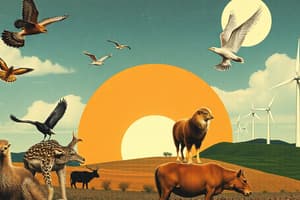Podcast
Questions and Answers
Which of the following is NOT a characteristic of mammals?
Which of the following is NOT a characteristic of mammals?
What is the main difference between a frog and a toad?
What is the main difference between a frog and a toad?
Which of these pairs represents two types of renewable energy sources?
Which of these pairs represents two types of renewable energy sources?
Which of the following statements about endangered species is TRUE?
Which of the following statements about endangered species is TRUE?
Signup and view all the answers
Which of the following animals is NOT an insect?
Which of the following animals is NOT an insect?
Signup and view all the answers
Which of the following statements is TRUE about deciduous trees?
Which of the following statements is TRUE about deciduous trees?
Signup and view all the answers
Which of the following actions can contribute to protecting endangered species?
Which of the following actions can contribute to protecting endangered species?
Signup and view all the answers
Which of the following statements is TRUE about the relationship between animals and their habitats?
Which of the following statements is TRUE about the relationship between animals and their habitats?
Signup and view all the answers
What is the primary threat facing wildlife, according to the content?
What is the primary threat facing wildlife, according to the content?
Signup and view all the answers
Which of these are specifically mentioned as contributing to the greenhouse effect?
Which of these are specifically mentioned as contributing to the greenhouse effect?
Signup and view all the answers
What type of animal gives birth to live young?
What type of animal gives birth to live young?
Signup and view all the answers
What is the primary cause of soil pollution according to the content?
What is the primary cause of soil pollution according to the content?
Signup and view all the answers
What is the main difference between renewable and non-renewable energy sources?
What is the main difference between renewable and non-renewable energy sources?
Signup and view all the answers
What is the role of conservation efforts in addressing environmental challenges?
What is the role of conservation efforts in addressing environmental challenges?
Signup and view all the answers
Which of these is NOT a solution to the environmental problems discussed in the text?
Which of these is NOT a solution to the environmental problems discussed in the text?
Signup and view all the answers
What is the main message the content conveys about the relationship between humans and the environment?
What is the main message the content conveys about the relationship between humans and the environment?
Signup and view all the answers
Flashcards
Endangered Species
Endangered Species
Species at risk of extinction due to various factors.
Greenhouse Gases
Greenhouse Gases
Harmful gases that trap heat in the atmosphere.
Deforestation
Deforestation
The process of cutting down trees, harming wildlife habitats.
Herbivores, Carnivores, Omnivores
Herbivores, Carnivores, Omnivores
Signup and view all the flashcards
Acid Rain
Acid Rain
Signup and view all the flashcards
Amphibians
Amphibians
Signup and view all the flashcards
Oviparous vs. Viviparous
Oviparous vs. Viviparous
Signup and view all the flashcards
Renewable Energy
Renewable Energy
Signup and view all the flashcards
Greenhouse effect
Greenhouse effect
Signup and view all the flashcards
Habitat preservation
Habitat preservation
Signup and view all the flashcards
Pollution sources
Pollution sources
Signup and view all the flashcards
Viviparous
Viviparous
Signup and view all the flashcards
Oviparous
Oviparous
Signup and view all the flashcards
Study Notes
Endangered Species and Extinction
- Many species face extinction risk.
- Protecting habitats and preventing deforestation are crucial to preventing extinction.
Animal Classification
- Herbivores eat plants; carnivores eat meat; omnivores eat both.
- Animals have varying body coverings (scales, fur).
- Mammals are viviparous (give birth to live young); reptiles and fish are oviparous (lay eggs).
Environmental Challenges
- Pollution (e.g., pesticides) and climate change (e.g., greenhouse effect) threaten ecosystems.
- Greenhouse gases trap heat, causing global warming and extreme weather events.
- Soil, air, and water contamination result from excessive pesticide use.
Energy Sources and Conservation
- Fossil fuels (oil, natural gas, coal) are non-renewable sources and pollute.
- Renewable energy (solar, hydropower) are safer alternatives to fossil fuels.
- Conservation is essential to protect ecosystems and wildlife.
Studying That Suits You
Use AI to generate personalized quizzes and flashcards to suit your learning preferences.
Description
This quiz explores the risks faced by endangered species, the importance of habitat protection, and the impact of pollution and climate change on ecosystems. It also covers animal classification and different energy sources, including the differences between renewable and non-renewable energies. Test your knowledge on these crucial environmental topics!




